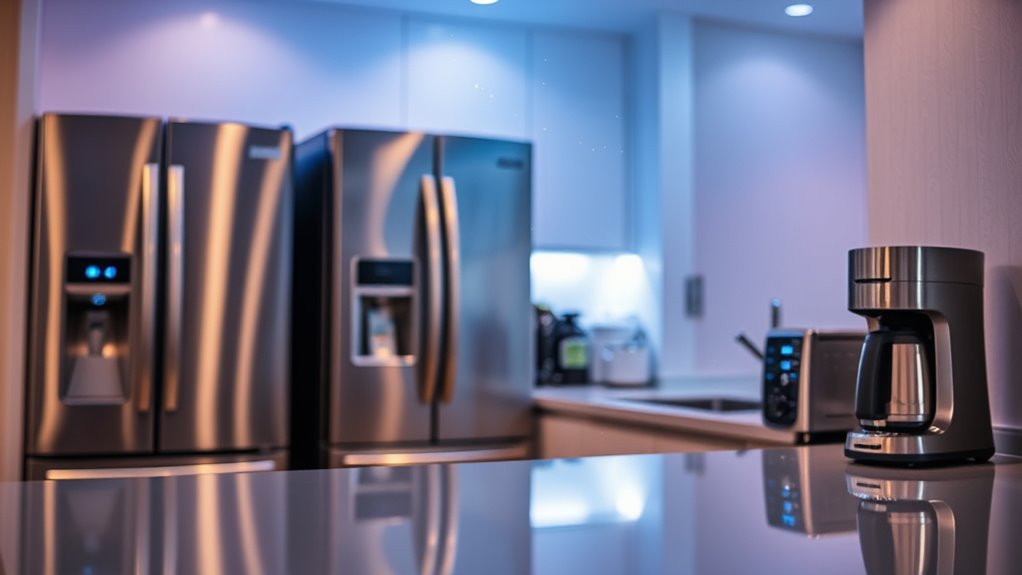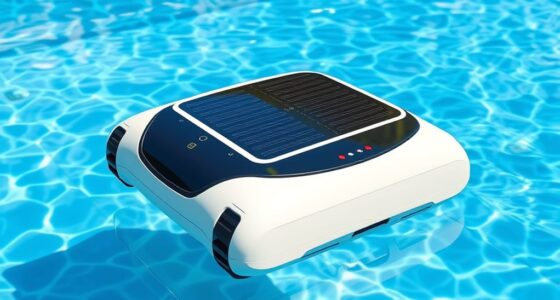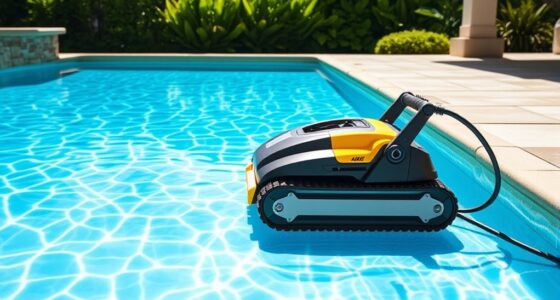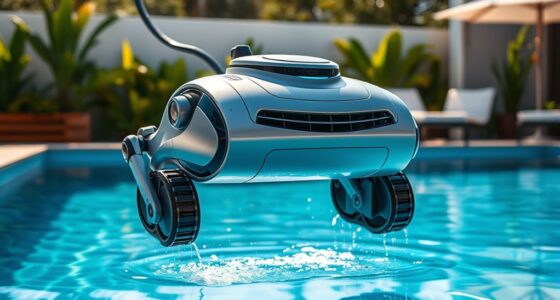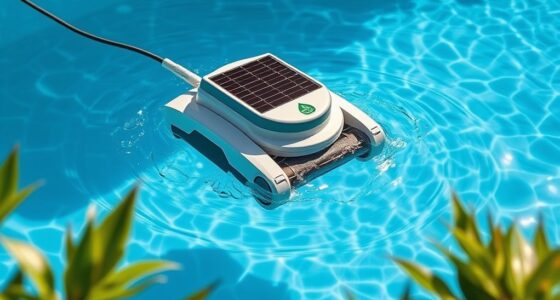UV-C sanitizing cycles can effectively kill germs by using ultraviolet light to destroy their DNA and RNA, preventing bacteria and viruses from reproducing. These cycles disinfect surfaces and objects quickly and without chemicals, making them a safe option for many environments. However, proper use and safety precautions are essential to avoid UV-C exposure to skin and eyes. To discover how to maximize their effectiveness, keep exploring the details behind UV-C technology.
Key Takeaways
- UV-C technology kills germs by damaging their DNA or RNA, preventing reproduction and infection.
- It offers quick, chemical-free sanitization for surfaces and objects within minutes.
- Proper use and safety precautions are essential to avoid skin or eye exposure.
- UV-C appliances effectively reduce surface germs, lowering infection risks in various settings.
- They are suitable for sanitizing high-touch items like phones and keys, ensuring consistent hygiene.
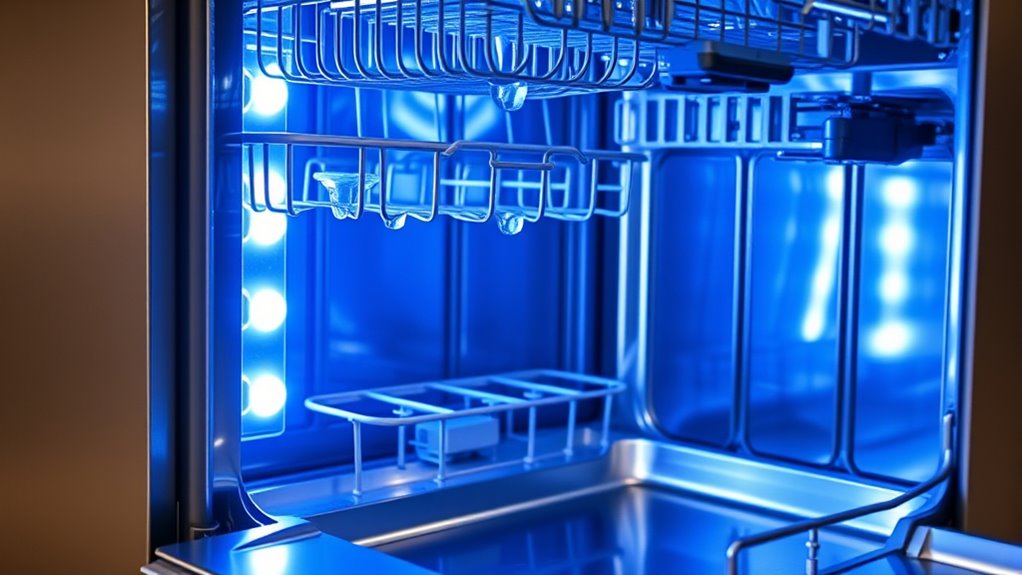
UV-C sanitizing cycles have become an effective way to disinfect surfaces and objects quickly and safely. If you’re looking to reduce germs around your home or workplace, understanding how UV C technology works can help you make smarter choices. This technology uses ultraviolet light in the C spectrum to target and destroy bacteria, viruses, and other harmful microorganisms. When you activate a UV-C cycle, your appliances emit this specific wavelength, which penetrates the cell walls of germs and disables their DNA or RNA. As a result, these pathogens can no longer reproduce or cause infection. This process is fast, typically taking just minutes, making it an efficient way to sanitize items without using chemicals or excessive water.
One of the most important health benefits of UV-C technology is that it provides a chemical-free method of disinfection. Unlike traditional cleaning products that may contain harsh ingredients, UV-C cycles do not leave residues or fumes, reducing potential health risks for you and your family. If you have allergies or sensitivities, this can be especially advantageous. Additionally, UV-C sanitizing can be performed without physical contact, which minimizes cross-contamination. For example, you can run a cycle on your toothbrush, phone, or keys without manually wiping them down, ensuring thorough coverage and reducing the chance of missing spots. This makes UV-C appliances particularly useful for high-touch items or objects that are difficult to clean manually.
Another notable health benefit is the potential to lower the spread of infectious diseases. Regular use of UV-C sanitizing cycles can greatly diminish the presence of germs on surfaces, which is vital in environments like hospitals, gyms, or homes with immunocompromised individuals. Since UV C technology doesn’t require physical scrubbing, it’s easier to maintain a consistent sanitation routine. Furthermore, because UV-C light kills pathogens quickly and effectively, you can have peace of mind knowing that your environment is safer. It’s important to note, though, that UV-C light isn’t suitable for direct exposure to skin or eyes, so appliances should be used with proper precautions to avoid accidental exposure. Additionally, understanding the variety of pinball machines and their features can help you select the most engaging options for entertainment.
Frequently Asked Questions
Are UV-C Sanitizing Cycles Safe for All Materials?
You might wonder if UV-C sanitizing cycles are safe for all materials. It’s important to account for material compatibility, as some plastics, fabrics, or electronics could be damaged by UV-C exposure. While these cycles can help disinfect your appliances, they might impact appliance durability depending on the materials involved. Always check manufacturer guidelines before using UV-C sanitizing features to ensure your items stay safe and intact.
How Long Do UV-C Cycles Need to Run Effectively?
Ironically, you might think a quick UV exposure is enough, but effective sanitization depends on proper cycle duration. Typically, UV-C cycles need to run anywhere from a few seconds to several minutes, depending on the appliance and germ type. Longer cycle durations ensure thorough pathogen destruction, making sure your appliances truly sanitize. Rushing the process could leave germs behind, so trust the recommended time rather than shortcuts for real cleanliness.
Can UV-C Light Penetrate All Types of Surfaces?
You might wonder if UV‑C light can penetrate all surfaces. It doesn’t easily reach through dense or textured surfaces due to surface textures that block its path. Additionally, material reflectivity matters—shiny or reflective surfaces help bounce UV‑C light, increasing effectiveness, while matte and porous materials absorb it, reducing germ-killing ability. So, UV‑C light isn’t equally effective on all surfaces, especially those with complex textures or low reflectivity.
Do UV-C Appliances Emit Any Harmful Byproducts?
You might wonder if UV-C appliances emit harmful byproducts. Generally, UV-C light itself doesn’t produce ozone or dangerous substances, but some units with ozone generation features can release small amounts of ozone, which may cause irritation. Also, prolonged exposure can lead to material degradation of plastics and fabrics. Always check your appliance specifications to guarantee it’s safe and doesn’t emit ozone or cause damage during use.
How Often Should I Run UV-C Sanitizing Cycles?
Ever wonder if you’re overdoing it? You should follow the recommended frequency guidelines for your UV-C appliances to guarantee optimal germ-killing without unnecessary wear. Typically, running a sanitizing cycle once a week or as part of your regular appliance maintenance is enough for most household needs. Check your appliance’s manual for specific instructions. Regular use keeps germs at bay, but overuse might reduce your device’s lifespan.
Conclusion
Ultimately, understanding UV-C’s capabilities clarifies its cleaning charm. While UV-C cycles can certainly sanitize surfaces, they don’t replace thorough cleaning or guarantee germ-free greatness. Don’t depend solely on devices — diligently disinfect, disinfect, disinfect! By blending basic hygiene with high-tech help, you’re better protected. So, stay savvy, stay safe, and don’t shy away from science—because smart sanitation starts with knowing what works and what doesn’t.
